Written By: Leo Kolivakis 
When a prominent market bear throws in the towel, it either means stocks are headed much higher or we are at an important reversal point.
Which is it? If you ask BlackRock's CEO Larry Fink, the stock market is at ‘risk of a melt-up, not a meltdown’. “Despite where the markets are in equities, we have not seen money being put to work,” Fink said. “We have record amounts of money in cash.”Fink also said the dovishness of central bankers creates a shortage of “good assets,” which could serve as a trigger for a global melt-up in equity prices.In his weekly market comment, Show Me The Money!, Martin Roberge of Cannacord Genuity notes the following:"Our focus this week is on the current breakout attempt in the S&P 500, and comparing it with previous breakout experiences in this cycle. The 25% jump since December lows has been spectacular given the weak earnings backdrop. That said, it is not unusual for stocks to thrive without earnings support when central banks dial down rate-hike expectations. But, at the end of the day, stocks follow the direction of earnings and this direction is down."As our Chart of the Week shows, when the S&P 500 made a sustainable breakout in 2013 and 2016, forward EPS growth and net earnings revisions had already bottomed out, with global economic momentum troughing and accelerating. In other words, earnings fueled the breakout and this is among reasons we stayed OW equities and recommended buying dips. This time around, the situation is the opposite, with global growth momentum down to 2008 levels and falling, meaning that the yearly change of 7% in the S&P 500 forward EPS is still too high. Thus, the S&P 500 appears to be too far ahead of its earnings cycle for a sustained break-out to occur, hence our UW stance on US equities.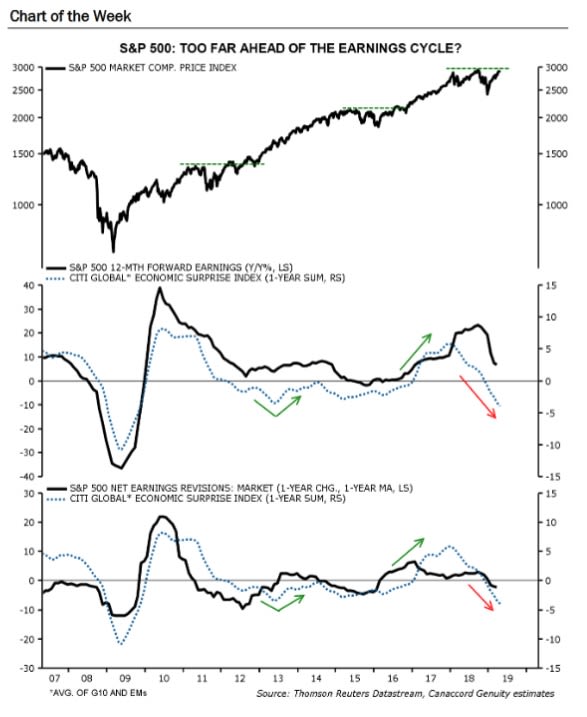 History has taught us that risk assets like stocks tend to overshoot and undershoot over a short period but Martin is right, over a longer period, stocks follow the direction of earnings and the direction is currently down.Still, there are so many CTAs and other large leveraged trading outfits long stocks that it's hard to predict whether the stock market is peaking here or truly at risk of melting up.And with the Fed on hold, some market observers are worried that the stock market is partying like it's 1999:"There are some striking similarities between the stock-market rebound — the S&P 500 is up about 15% year to date — and the rally at the end of the dot-com boom in 1999, Leuthold Group strategist Doug Ramsey points out in a recent note.""First, the “market is up almost every day, and one can almost bank on a ramp higher during the last 15 minutes,” he writes. “‘Corrections’ are now events that last hours, not days or weeks.”"Second, growth stocks are outperforming value stocks consistently. And U.S. shares have outperformed those in the rest of the world since December’s selloff, boosted in part by a stronger dollar, he writes.""Looking ahead. If history is any guide, that probably isn’t great news. While stocks rallied for another year after 1999, those gains led to unsustainable valuations. By 2002, the Nasdaq had slid roughly 75% from its early-2000 peak.""There are some reasons this year seems different, Ramsey writes. Investors aren’t as optimistic about growth, and have been “forced” into growth stocks because of low yields elsewhere. ""Even so, this rally led to similarly risky bets, he writes. “Is it reasonable to expect a different outcome?”
History has taught us that risk assets like stocks tend to overshoot and undershoot over a short period but Martin is right, over a longer period, stocks follow the direction of earnings and the direction is currently down.Still, there are so many CTAs and other large leveraged trading outfits long stocks that it's hard to predict whether the stock market is peaking here or truly at risk of melting up.And with the Fed on hold, some market observers are worried that the stock market is partying like it's 1999:"There are some striking similarities between the stock-market rebound — the S&P 500 is up about 15% year to date — and the rally at the end of the dot-com boom in 1999, Leuthold Group strategist Doug Ramsey points out in a recent note.""First, the “market is up almost every day, and one can almost bank on a ramp higher during the last 15 minutes,” he writes. “‘Corrections’ are now events that last hours, not days or weeks.”"Second, growth stocks are outperforming value stocks consistently. And U.S. shares have outperformed those in the rest of the world since December’s selloff, boosted in part by a stronger dollar, he writes.""Looking ahead. If history is any guide, that probably isn’t great news. While stocks rallied for another year after 1999, those gains led to unsustainable valuations. By 2002, the Nasdaq had slid roughly 75% from its early-2000 peak.""There are some reasons this year seems different, Ramsey writes. Investors aren’t as optimistic about growth, and have been “forced” into growth stocks because of low yields elsewhere. ""Even so, this rally led to similarly risky bets, he writes. “Is it reasonable to expect a different outcome?”So are we headed for another 1999-style tech melt-up?
Nobody knows but look at the year-to-date performance of the S&P major sectors courtesy of barchart: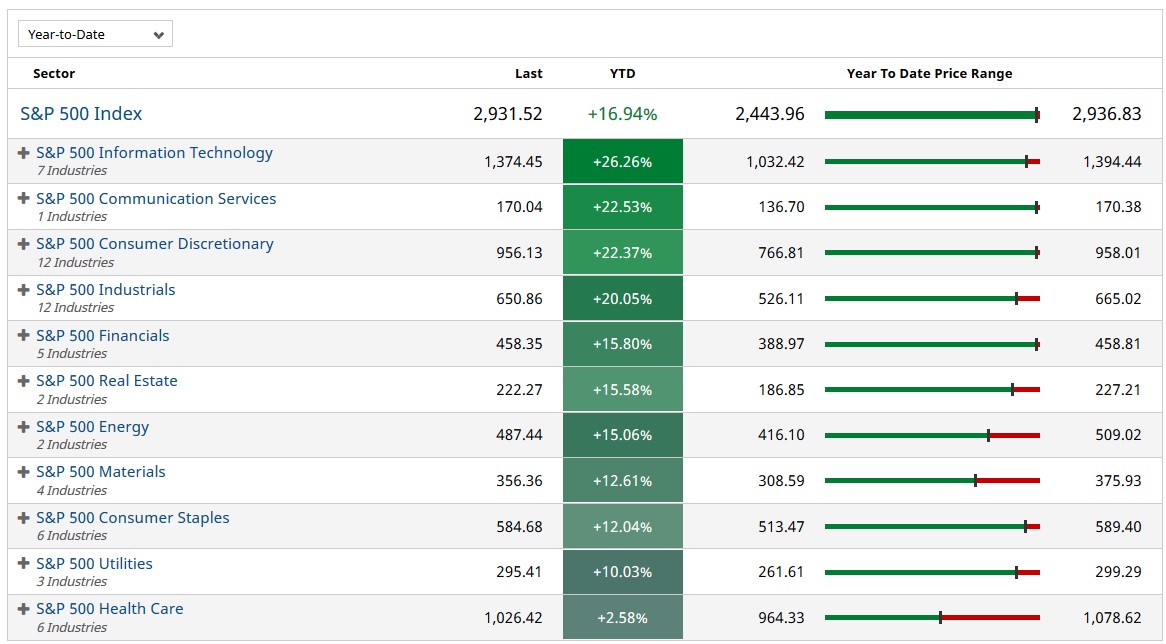 As you can see, the S&P 500 is up 17% YTD, led by Information Technology (+26.3%), Communication Services (+22.5%), Consumer Discretionary (+22.4%) and Industrials (+20%).The three lagging sectors are all defensive, Consumer Staples (+12%), Utilities (+10%) and Healthcare (+3%).If you believe a melt-up is on its way, you need to be playing the momentum game chasing tech stocks higher but if you believe a reversal will materialize, you're better off focusing on stable/ defensive sectors.My quick reading of S&P Technology index ( XLK[ARCA] - $78.71 ) is it has gone parabolic here and while momentum is definitely up, I'm expecting a pullback back to its 50-week moving average and possibly below if markets sell off hard:
As you can see, the S&P 500 is up 17% YTD, led by Information Technology (+26.3%), Communication Services (+22.5%), Consumer Discretionary (+22.4%) and Industrials (+20%).The three lagging sectors are all defensive, Consumer Staples (+12%), Utilities (+10%) and Healthcare (+3%).If you believe a melt-up is on its way, you need to be playing the momentum game chasing tech stocks higher but if you believe a reversal will materialize, you're better off focusing on stable/ defensive sectors.My quick reading of S&P Technology index ( XLK[ARCA] - $78.71 ) is it has gone parabolic here and while momentum is definitely up, I'm expecting a pullback back to its 50-week moving average and possibly below if markets sell off hard: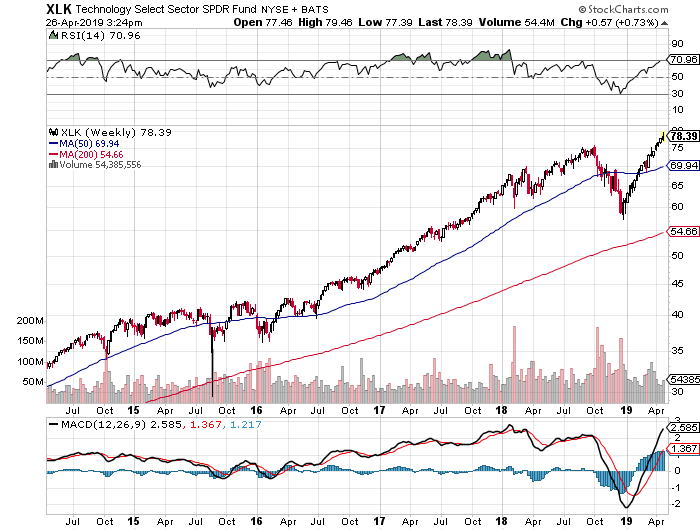 Conversely, the S&P Healthcare index XLV remains directionless, up from its December lows but not making new highs and rolling over:
Conversely, the S&P Healthcare index XLV remains directionless, up from its December lows but not making new highs and rolling over: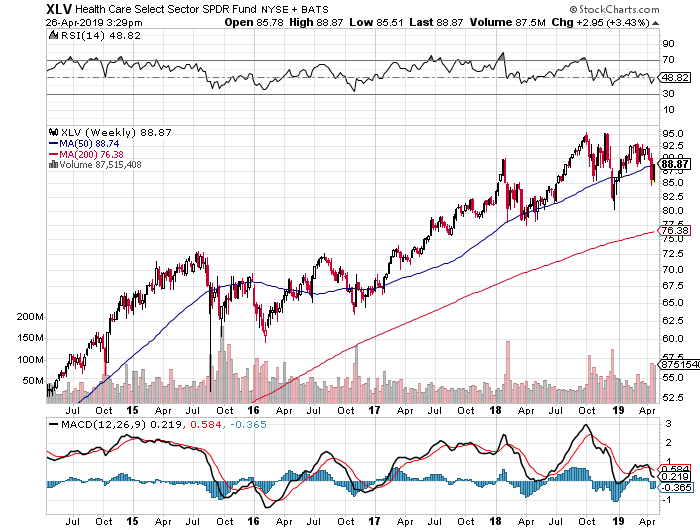 Technical analysts will tell you stick with what's going up (tech), buy the breakouts, but that advice works until it doesn't.Nobody rings a bell when stocks roll over, they just do, but in a low growth/ low return world, I can assure you the world's largest asset allocators are going to be rebalancing before the end of Q2 if stocks keep melting up, just as they did last Christmas when they bought the 'meltdown' dip hard.By the way, as tech stocks melt up, US long bond prices ( TLT[NSD] - $123.65 Trade ) are firming up, lending support to the US dollar ( UUP[ARCA] - $26.17 ) as it's inching closer to making a new high:
Technical analysts will tell you stick with what's going up (tech), buy the breakouts, but that advice works until it doesn't.Nobody rings a bell when stocks roll over, they just do, but in a low growth/ low return world, I can assure you the world's largest asset allocators are going to be rebalancing before the end of Q2 if stocks keep melting up, just as they did last Christmas when they bought the 'meltdown' dip hard.By the way, as tech stocks melt up, US long bond prices ( TLT[NSD] - $123.65 Trade ) are firming up, lending support to the US dollar ( UUP[ARCA] - $26.17 ) as it's inching closer to making a new high: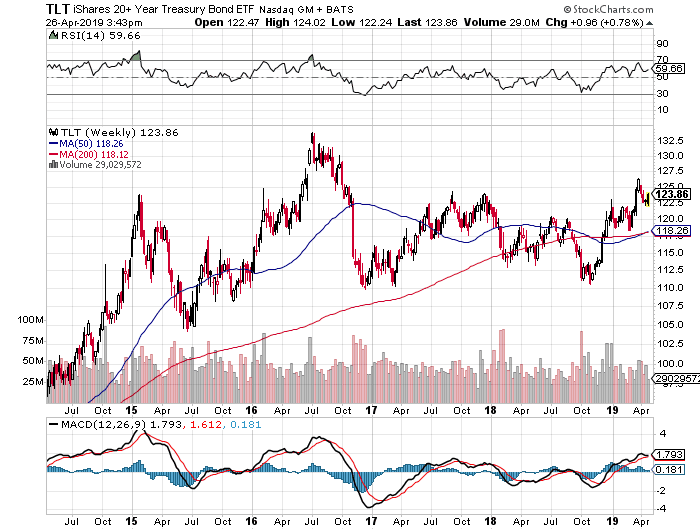
 What this tells me is global investors are hedging their stock market bets, buying good old US bonds.Of course, the rise in the US dollar isn't bullish for emerging markets ( EEM[ARCA] - $43.93 ) and if it starts impacting more large US corporations like 3M ( MMM[NYE] - $189.51 Trade ), President Trump might have to intervene as he did with oil last week:
What this tells me is global investors are hedging their stock market bets, buying good old US bonds.Of course, the rise in the US dollar isn't bullish for emerging markets ( EEM[ARCA] - $43.93 ) and if it starts impacting more large US corporations like 3M ( MMM[NYE] - $189.51 Trade ), President Trump might have to intervene as he did with oil last week: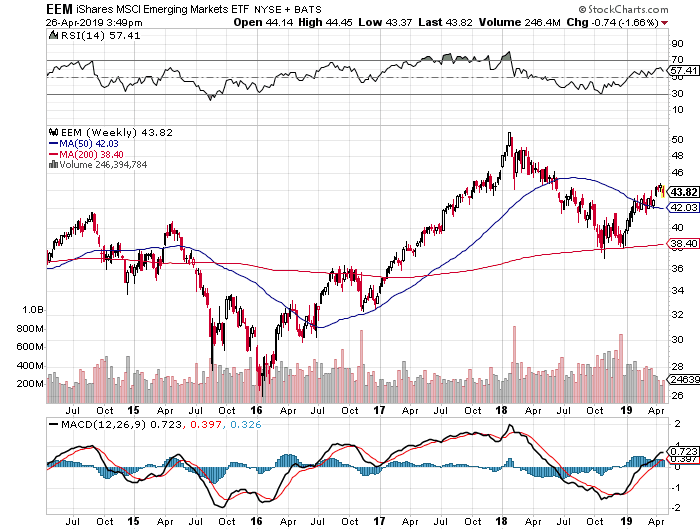
 Stay tuned, the second half of the year will be a lot more interesting than the first half.Below, Morgan Stanley's Mike Wilson joins the 'Fast Money Halftime Report' team to discuss the markets as the Nasdaq and the S&P 500 near their record highs.Second, Blackstone's Joseph Zidle joins CNBC's Futures Now for a discussion of the first quarter corporate earnings season, interest rate changes and other potential risks to the current bull market.Third, Lakshman Achuthan, COO of the Economic Cycle Research Institute, discusses risks of a global economic slowdown and its impact on commodities demand from Canada.Lastly, Lacy Hunt was on MacroVoices this week. You can listen to the podcast here, well worth it.
Stay tuned, the second half of the year will be a lot more interesting than the first half.Below, Morgan Stanley's Mike Wilson joins the 'Fast Money Halftime Report' team to discuss the markets as the Nasdaq and the S&P 500 near their record highs.Second, Blackstone's Joseph Zidle joins CNBC's Futures Now for a discussion of the first quarter corporate earnings season, interest rate changes and other potential risks to the current bull market.Third, Lakshman Achuthan, COO of the Economic Cycle Research Institute, discusses risks of a global economic slowdown and its impact on commodities demand from Canada.Lastly, Lacy Hunt was on MacroVoices this week. You can listen to the podcast here, well worth it.


